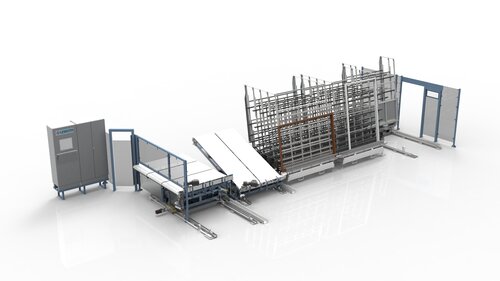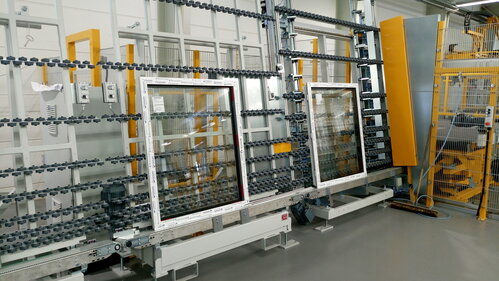sash and frame
Automatic stacking device - AS 165.K
Automatic stacking of frames or sashes
The stacking device AS165 is an ideal addition to automated production lines.Depending on the model used, the frames or sashes are deposited either in roller trolleys or compartment racks. It is possible to integrate a slewing unit to adjust the turning position of the window. Different levels of programming enable the stacking device to specifically suit the requirements of your production line.
Stacking in roller trolleys and/or compartment racks
For stacking, roller trolleys are connected to the stacking device. Depending on the model, a roller trolley can take up to 10 frames or sashes and there can be as many roller trolleys used as required. The roller trolleys can easily be pushed by one person.
A capacity of up to 40 units can be taken by the standard model when stacking in the compartment rack. The combination of compartment rack and roller trolley is also possible.
Slewing unit for correct turning position
If the components of the preliminary machine are not off-loaded in the correct turning position, then a slewing unit can turn the window unit around 90° from the transfer edge to the raised edge before stacking takes place. Thus the window always stands up on the correct side in the compartment, which is preferable for further processing.
Free choice of stacking direction
The manufacturing concept and space proportions in the work area determine the type of stacking unit. As a result, the windows - according to the selected stacking direction - can be transported and stacked lengthways or sideways to the transportation direction of the preliminary machine.
"Stupid" or "clever" stacker
The programming of the machine defines the "intelligence" of the stacking device. While stackers without data transfer feature to the subsequent machine are described as "stupid" stackers, models with data transfer are termed "clever" stackers. When stacking without data transfer, the window units are deposited each time in the correct order of the flow of components in the next available compartment. "Clever" stackers pass on the information, that they receive during the on-loading process through online databases, serial interfaces or barcode scanners, to a subordinated work area - e.g. to a frame-hinging work area. With this model the stacking takes place in a numbered compartment rack, in roller trolleys with trolley identification or in a combination of both.
Further special functions, like special faulty component handling, can likewise be integrated.
Latest modification: 07.02.2022



